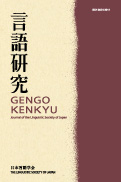
- |<
- <
- 1
- >
- >|
-
Hideki Kishimoto2018 Volume 153 Pages 5-39
Published: 2018
Released on J-STAGE: December 29, 2018
JOURNAL FREE ACCESSOn the basis of NPIs licensed under the scope of negation, this article shows that in Japanese, a negative head introduced in the head position of NegP extends its scope over TP if it undergoes Neg-head raising. While a grammatical negator (paired with lexical verbs) is subject to Neg-head raising, a lexical negator retaining original categorical properties as an adjective does not undergo Neg-head raising, in which case negative scope extends only over vP. By making use of the raising construction headed by the aspectual verb iru ‘be’, it is shown that subjects undergo raising to Spec-TP when the clause includes a nominative argument, but that oblique subjects may remain in their base-generated predicate-internal position. It is also shown that there are two types of raising constructions formed on the verb naru ‘become’—one type in which the subject of the embedded verb is moved to the matrix clause, and the other in which the embedded subject moves only in the embedded clause.*
View full abstractDownload PDF (590K) -
Keita Kurabe2018 Volume 153 Pages 41-55
Published: 2018
Released on J-STAGE: December 29, 2018
JOURNAL FREE ACCESSThe aim of this paper is to argue that several distinct phonological phenomena in Jinghpaw such as phonological gaps in the phoneme inventory, morphophonological alternations of prefixes, and similarity avoidance effect in the lexicon, can be uniformly accounted for in terms of deaspiration or aspiration dissimilation. The present paper, by taking into consideration that voiceless fricatives in the language are phonologically specified for [+spread glottis] like aspirated stops based on phonological gaps in the consonant inventory, shows that the Obligatory Contour Principle (OCP) on the [spread glottis] tier accounts for several types of prefix alternations involving aspirated stops and voiceless fricatives. This paper also examines the Jinghpaw lexicon, highlighting a distributional asymmetry involving [spread glottis] in the lexicon, and shows that the asymmetry is due to the ban against multiple [+spread glottis] on the [spread glottis] tier.*
View full abstractDownload PDF (571K) -
Gakuji Kumagai, Shigeto Kawahara2018 Volume 153 Pages 57-83
Published: 2018
Released on J-STAGE: December 29, 2018
JOURNAL FREE ACCESSThe question of whether linguistic knowledge is binary (i.e., grammatical vs. ungrammatical) or stochastic is one of the most important questions in general linguistic inquiry. Much recent work in the last few decades has argued that phonological knowledge is stochastic (e.g., Hayes & Londe 2006). Building on this body of research, we show that in Japanese, gradient phonological knowledge affects several word formation patterns in stochastic ways. Concretely, we show that identity avoidance effects hold at both the segmental and the CV-moraic levels and stochastically affect two types of word formation patterns in Japanese: group name formation and rendaku. We show that Maximum Entropy Grammar (Goldwater & Johnson 2003), together with multiple OCP constraints (Coetzee & Pater 2008), successfully models both of the observed morphological word formation patterns without any further stipulation. In addition to this theoretical contribution, one of the patterns discussed in this paper—group name formation—has not been analyzed from the perspective of formal phonological theories before, and hence this paper has descriptive novelty as well.*
View full abstractDownload PDF (748K)
- |<
- <
- 1
- >
- >|